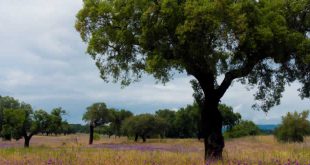Crocus — Crocus (plural: crocus, crocuses) is a genus of perennial flowering plants, native to a large area from coastal and subalpine areas of central and southern Europe (including the islands of the Aegean), North Africa and the Middle East, across Central Asia to western China. The genus Crocus is placed botanically in the iris family (Iridaceae). The plants grow …
Read More »Search Results for: south africa
Cowpea
Cowpea — The Cowpea (Vigna unguiculata) is one of several species of the widely cultivated genus Vigna. Cowpeas are one of the most important food legume crops in the semi-arid tropics covering Asia, Africa, southern Europe and Central and South America. A drought tolerant and warm weather crop, cowpeas are well-adapted to the drier regions of the tropics, where other …
Read More »Cork Oak Tree Encyclopedia
Kingdom: Plantae Family: Fagaceae Order: Fagales Genus: Quercus Cork Oak Tree — The Cork Oak (Quercus suber) is a medium-sized, evergreen oak tree in the section Quercus sect. Cerris. It is native to southwest Europe and northwest Africa. It grows to up to 20 m, although it is typically more stunted in its native environment. The leaves are 4-7 cm …
Read More »Coriander
Coriander — Coriander, Coriandrum sativum, also commonly called cilantro, is an annual herb in the family Apiaceae. Coriander is native to southwestern Asia and west to north Africa. It is a soft, hairless plant growing to 50 cm [20 in.] tall. The leaves are variable in shape, broadly lobed at the base of the plant, and slender and feathery higher …
Read More »Collard
Collard — Collards, also called borekale (from the Dutch boerenkool (farmerskale), Brassica oleracea Acephala Group), are various loose-leafed cultivars of the cabbage plant. The plant is grown for its large, dark-colored, edible leaves and as a garden ornamental, mainly in Brazil, Portugal, the Southern United States, many parts of Africa, Montenegro, Spain and in Kashmir as well. They are classified …
Read More »Cineraria
Cineraria — Cineraria is now generally treated as a genus of about 50 species of flowering plants in the family Asteraceae, native to southern Africa. The genus includes herbaceous plants and small subshrubs. In the past, the genus was commonly viewed in a broader sense including a number of species from the Canary Islands and Madeira which are now transferred …
Read More »Black-Eyed Susan Vine
Black-Eyed Susan Vine — Thunbergia alata, commonly called Black-eyed Susan vine, is a herbaceous perennial climbing plant species in the Acanthaceae family. It is native to Eastern Africa, and has been naturalized in other parts of the world. It is found in Cerrado vegetation of Brazil and Hawaii, along with eastern Australia and the southern USA in the states of …
Read More »Buckthorn
Buckthorn — The Buckthorns (Rhamnus) are a genus (or two genera, if Frangula is treated as distinct) of about 100 species of shrubs or small trees from 1-10 m tall (rarely to 15 m), in the buckthorn family Rhamnaceae. They are native throughout the temperate and subtropical Northern Hemisphere, and also more locally in the subtropical Southern Hemisphere in parts …
Read More »Boxwood
Boxwood — Buxus is a genus of about 70 species in the family Buxaceae. Common names include box (majority of English-speaking countries) or boxwood (North America). The boxes are native to western and southern Europe, southwest, southern and eastern Asia, Africa, Madagascar, northernmost South America, Central America, Mexico and the Caribbean, with the majority of species tropical or subtropical; only …
Read More »Begonia
Begonia — Begonia is a genus in the flowering plant family Begoniaceae. The only other member of the family Begoniaceae is Hillebrandia, a genus with a single species in the Hawaiian Islands. The genus Symbegonia is now included in Begonia. “Begonia” is the common name as well as the generic name for all members of the genus. With ca. 1500+ …
Read More » Kids Portal For Parents India Kids Network
Kids Portal For Parents India Kids Network
